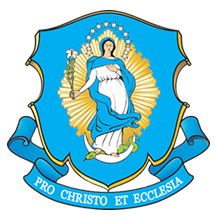
The National Shrine of The Divine Mercy in Stockbridge, Mass., is a monument that not only highlights the mercy of God but is a consequence of the Marians trusting in God.
The late Marian Provincial, Very Rev. Joseph Luniewski, MIC, was among a number of Marian Fathers who wanted to express their recognition of the Immaculate Conception and draw attention to the greatest attribute of God. The Marian Fathers initial idea was to build a simple house chapel dedicated to the Immaculate Conception, where the community Masses and spiritual exercises could be celebrated. The reason for this modest initiative was due to limited resources available at the time. Little did they realize what awaited them. The result was beyond their expectations. Their trust was further evidenced by their choice of an Italian craftsman by the name of Mr. Antonio Guerrieri who knew very little about constructing churches. He was a wood carver and cabinet maker par excellence and well known for his ability to renovate churches. The Marians trusted Mr. Guerrieri not only to construct but to design the interior of the chapel.
One of the reasons that Mr. Guerrieri agreed to design and build the church was due to a cultural tradition in his native Italy. Through the centuries, families of artisans, sculptures, wood carvers, and masons, would often want to leave a legacy among their kindred. They proposed doing this by building churches and cathedrals that would last a lifetime. They saw little need to construct these edifices in one lifetime. They took pleasure to passing on the effort to their children and grandchildren. Mr. Guerrieri told me several times that he never thought he would live to see the final results of building the chapel since this was not a necessary value in his culture. He simply wanted to build something out of gratitude to God. We are the beneficiaries of that initiative.
Mr. Guerrieri worked from general drawings that he had submitted for approval. When a need arose, he would scan architectural books which I often saw lying on workbenches gathering dust. However, he took the advice from other experienced masons on how to build a solid cement foundation and proceeded accordingly. Some of the walls in the basement are approximately four feet thick. Other workers such as plumbers, electricians, and assorted vendors were hired as the need arose.
When I came on the scene in June of 1951, the foundation and first wooden portions to support the brick façade were already in place. Now the major effort consisted of bringing in bricks from an abandoned school. These bricks comprised the outer façade of the chapel, which very slowly began to take shape. Each of these very large slabs of rock had to be sized and prepared for cementing into place. They were hauled up by hand, and the work was progressively more difficult as the height of the chapel began to increase. The very next day after my arrival brought me to see this massive effort and to hear the constant chipping of bricks being cleaned by the Marian brothers and some priests, notably Fr Fidelis Grabowski MIC. The workers affectionately called us the "chip monks." It was an echo that reverberated throughout the entire summer.
My first opportunity to work at the chapel began when I was asked to putty all the glass windows that were to be used in the rooms connecting a portion of the monastery to the shrine. This alone took months to complete. After this was finished, Mr. Guerrieri thought it might be appropriate for one of us Marians to contribute something to the carvings that would decorate the interior of the chapel. Besides Mr. Guerrieri, there were two other expert carvers present. He first trained me in using the intricate tools. I saw how carefully he handled these very sharp chisels, almost as if they were jewels. My initial effort was to carve twelve rosette figures. They were to become a set of panels that would be inserted in the doors at the entrance to the chapel. The design was configured according to the Romanesque style. The oak wood was extremely hard and in time notable calluses appeared on the palm of my right hand. It reminded me of what a hardened soul must look like. After completing this project, Mr. Guerrieri then allowed me to carve something more intricate. This was a set of ten "keystones" that can be seen above all the stained-glass windows in the chapel. They serve as the "center piece" for the round arches that are joined together above these same windows. Fortunately, the wood was much softer to carve, almost like pine but much richer in texture and color.
It was while carving these keystones that I had one of my most memorable and learning experiences working with Mr. Guerrieri. There was a point when I became rather tired and irritated at my lack of progress in carving some of these very detailed ornaments. Invariably, I also had to pause because the chisels had to be sharpened, otherwise they would not perform very well. Since these keystones were to be placed rather high on the wall, I subtly complained to Mr. Guerrieri about no one really appreciating all this effort from that distance. I still remember him taking my arm and squeezing it. Then with a fatherly look in his gentle eyes, he said: "But don't you know? God sees!" Well, I was totally embarrassed. He was using my language. I was supposed to say those sorts of things instead of him. However, he would never know how much that comment would help me during the following years when I experienced difficulties and countless frustrations. He was one of the best influences in my life and I will never forget that lesson. God truly does see all things. He can be trusted!
This experience also reminded me of the architectural books that Mr. Guerrieri used when he wanted a particular design carved by the other workers. Although there were hundreds of Romanesque churches and cathedrals shown in these books, none had ever included the name of the architect or builder. It stands to reason, that by the time these huge cathedrals were built it had taken well over a hundred years, so the original designers, builders, and artisans were long forgotten. This served as a tremendous influence on my own religious life. I realized it wasn't that important to be recognized for any particular talent or ability. All that mattered was that God be glorified in the end result.
Mr. Guerrieri must have picked this up from his culture. It was not important that his name or anyone else's be carved on some mural in the chapel. It was only important to know that God will see the result and that is all that matters in life. He sees our trust in Him and will reward accordingly. The satisfaction is also in knowing that God will respond in a way that will be uniquely His. Our Lord has indeed responded in more ways than we could ever have imagined. The Divine Mercy Shrine is now known all over the world, assisted by Mother Angelica's EWTN coverage of the annual Divine Mercy Sunday celebration at the Shrine. All this came about because in their trust, a humble group of Marian priests wanted to dedicate a small chapel to our Lady and honor the Mercy of God.
Other observations:
During the initial stages of construction, and due to the lack of funds, there were times when only one or two workers were available to continue the effort. Often the work came to a complete halt. (This is a familiar theme, in the light of The Divine Mercy message being under a ban from the Vatican for nearly 20 years.) Furthermore, during the winter months the building lacked adequate heat with simple wooden walls and the windows only covered with plastic. I recall the first Christmas Eve that I had as a novice. At 11:40 p.m., with only 20 minutes to spare before Midnight Mass, I was in my work clothes stoking the coal in the boiler to generate heat so that the newly laid cement would not freeze. Fortunately, Mass was delayed for 10 minutes due to a snow storm and I was able to join everyone unnoticed. That was one of the multiple times that Mr. Guerrieri's comment rang so gently in my ear: "But don't you know? God sees!"
There were several occasions when the unimaginable happened. Mr. Guerrieri was a perfectionist when it came to a carving that he did not approve. One of the completed arches took Mr. Stanley Socha several weeks to complete because it was so detailed. Unfortunately, it did not pass Mr. Guerrieri's inspection and had to be replaced with another design. There were other instances of carvings that were not approved and similarly discarded. The men became quite frustrated. However, they had to admit Mr. Guerrieri was right. They walked away but then calmed down, came back from a break, and started all over again - taking another month or two to get it just right. After all: "... God sees!"
Mr. Stanley Olender was also considered one of the best carvers in the area. He took great pride in carving the enormous details seen in the pulpit. All these intricate pieces took about six months to carve and I consider the pulpit a masterpiece and the greatest single display of craftsmanship in the chapel.
Eventually, after years of seeing only scaffolding in the shrine, the intricate carvings on the ceiling and walls were about complete. The beautiful and majestic imported Carrara marble statue of Our Lady of the Immaculate Conception was already in place. However, there was one more item that had to wait before all that scaffolding came down. It was decided that the Holy Spirit had to be displayed somehow and somewhere. Mr. Olender was called upon to provide his artistic skills. He carved an approximately three-foot wooden sculpture of a picture that was provided him from one of the books that was thought to be the Holy Spirit. After weeks of detailed, most intricate and painstaking artisanship, the image of the carved Holy Spirit was put on display. Eventually all the scaffolding came down, and when the Holy Spirit carving was observed without obstruction of the scaffolding, it caused great concern and had to be removed. The major reason being, that it resembled a Polish eagle and would be mistaken as a foreign icon. Eventually a painted image of the Lamb of God was placed in the ceiling and remains there to this day. The beautiful and ornate work of Mr. Olender was relegated for many years to a barn on the property, which affectionately was named "The Golden Eagle." But then: "... God sees!"
During the years that Mr. Guerrieri worked in our midst, he came to know many of the priests and brothers personally. He became aware of certain things and took note of them. One of these concerns involved decorating the chapel with flowers on significant occasions and feasts. As a result, he mentioned to me on several occasions that he took special pains to design and decorate the walls behind the main altar with elaborate "flower-like" motifs that were very ornately carved. He felt that this would be a permanent contribution to the altar so there would be little need for further decorations.
Visitors to the Shrine come to realize very quickly that there are very few "liturgical" symbols to be seen. The major reason is that Mr. Guerrieri, with all due respect, was not trained in this area. He was a master cabinet maker and wood carver of the highest standards. Therefore, he gave from his own skills and understanding of what comprises the building of a church. However, it must be admitted that he did design the concave area for all the wooden carved statues from Italy to have their special niche behind the altar. That was his way to convey some sense of what took place at the first liturgical celebration. Mr. Guerrieri was most sensitive to the color scheme. He insisted that the walls of the Shrine be left completely off-white, so that the beauty and the richness of the red cypress wood carvings would be revealed with greater appreciation. Upon completion, most everyone agreed that he was right. The contrast was striking.
With the completion of the woodcarvings, the Shrine was now ready to have the marble altar and floor installed. When the altar was put into place, even though the floor had only rough and exposed cement, Very Rev. Joseph Sielski, MIC, the Provincial Superior at the time, wanted to give thanks to our Lord in a special way. He conveyed this by celebrating the first Mass at the Shrine, well before its official consecration. His excitement at this historical occasion couldn't be contained and he celebrated Mass with extraordinary devotion and gratitude.
When the marble flooring was completed in the sanctuary and the pews were installed, the Marian community decided to have their Community Masses and prayers there. However, something was lacking. That missing element was found when the stained-glass windows were finally installed. The Shrine took on an entirely new character. It's as if it achieved its prime purpose. The Gospel stories of our Lord's mercy began to be revealed in the stained-glass images. To everyone's amazement, we finally had a respectable and prized possession on our hands. Mr. Frank Leuchs, who designed and installed the windows, would often mention to me 10 years into his profession that this was not only his first professional commission but his most prized effort as well. It was a project that brought him the most joy and personal satisfaction.
Since many pilgrims and benefactors saw the phenomenal results, the donations finally covered the remaining costs that had to be paid to various vendors and workers. Very Rev. Walter Pelczynski, MIC, then the Provincial Superior, should be credited for tirelessly working to see that every donation, no matter how small, would be used to pay off the construction.
Over a period of time, with everyone having a comment of one kind or another, it was inevitable that someone tried to improve on the Shrine. A painter was hired to render some images on the ceiling and walls. The painter was principally hired by other pastors in the region to beautify and enhance plastered imitation carvings in various churches. He would apply paint that would make it more attractive. He would often place gold leaf over plaster to make it look more elaborate than it was. When he arrived at the Shrine, he assumed that he was asked to do the same thing. He therefore placed gold leaf on the Carrara marble that did not need any elaboration. Similarly, he painted over with gold leaf many of the very intricate carvings that took away from the original beauty and grandeur of the wood itself. Finally, one 'fleur-de-lis' didn't seem to be enough, so he added multiple ones on the walls. The painter was well intentioned, but his effort relegates the natural beauty of the warm wood to that of cold plaster. If Mr. Guerrieri were alive today, I probably would have to return the favor he paid me by taking his arm and saying: "But now you know. God sees!"
There are still some things to be completed in the Shrine. For example, the stained- glass windows in the bell tower still wait to be installed. The tower itself is not completed and could be raised to symmetrical and architectural requirements. The main reason for this absence is due to the fact that at the time funds were not available. In addition, there were no longer any rocks to be obtained that would match the consistency of what was used in the lower exterior walls. The results of the Marian Fathers' trust in building a Shrine to The Divine Mercy is now well established. Pilgrims continue to be drawn to this small jewel in the Berkshires to honor God's mercy. We have been left a legacy, and if we trust in Jesus, the consequences can be even greater. Our trust will not be revealed in a building but in eternal union with Him.
Brother Leonard Konopka, MIC, lives at the Marians' house in Washington, D.C. He works as a Divine Mercy promoter in the D.C. area.
















